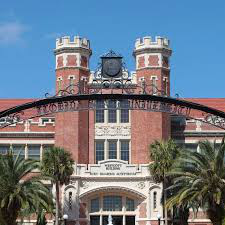Conveners
Proton: Parallel 2
- Gasparian Ashot (North Carolina A&T state University)
Proton: Parallel 2
- Dipangkar Dutta (Mississippi State University)
Near-threshold charmonium photoproduction opens the door for studying the gluonic properties of the proton: gluonic GPDs, anomalous contribution to the mass of the proton, gravitational form factors, and the mass radius of the proton. However, such an ambitious program requires precise measurements to validate the theoretical assumptions that relate the experimental results to the above...
$J/\psi$ photo-production near threshold provides a unique window into the non-perturbative structure of the gluonic fields of the nucleon, enabling access to information regarding the origin of its mass and mass radius. In the Jefferson Lab E12-16-007 experiment, we measured the two-dimensional $J/\psi$ photo-production cross-section as a function of photon energy $E_{\gamma}$ and momentum...
The conventional picture of the proton is based on three “valence” quarks—two “up” and one “down”. This picture has done a remarkable job of describing many properties of the proton. However, thanks to the richness of QCD, the proton is a much more complicated object. In addition to the valence quarks, the proton contains a “sea” of quark-antiquark pairs and gluons that bind the system...
The explicit sea quark distribution functions of proton have been calculated in the
chiral constituent quark model which has implications of chiral symmetry breaking and SU(3) symmetry breaking. The results have been discussed in detail for the sea quark asymmetries and the Gottfried integral in light of the latest SeaQuest data.
I discuss the scope and naturalness of the proton mass decomposition (or sum rule) published in PRL74, 1071 (1995), focusing particularly on its interpretation and the quantum anomalous energy contribution. I stress the importance of measuring the quantum anomalous energy through experiments. I will also discuss the mass radius and relation to the threshold J/psi production on the proton.
The proton charge radius is one of the important quantities in physics. For the past seventy years it has been measured through elastic electron-proton scattering and ordinary hydrogen spectroscopy methods. Over the years, results from both methods generally agreed with each other within their experimental uncertainties. Unexpectedly, in 2010 (and 2013) two experiments from newly developed...
The MUon Scattering Experiment (MUSE), which takes place at the PiM1 beamline of the Paul Scherrer Institut (PSI), aims to simultaneously measure elastic ep and μp scattering in order to determine the proton charge radius. However with the beamline and kinematics available to the experiment, MUSE has a broader physics reach than extracting the proton radius. As the experiment has access to...
This talk will discuss upcoming tagged deep inelastic scattering (TDIS) measurements in Hall A of Jefferson Lab, which will probe the elusive mesonic content of the nucleon. The TDIS experiment will measure low momentum recoiling (and spectator) hadrons in coincidence with deep inelastically scattered electrons from hydrogen (and deuterium) targets. The recently installed Hall A Super Bigbite...
I’ll discuss the role of the triangle anomaly in polarized deep inelastic scattering (DIS) employing a worldline formalism, which is a powerful framework for the computation of perturbative multi-leg Feynman diagrams. I’ll demonstrate that structure function $g_1(x_B,Q^2)$ measured in polarized DIS is dominated by the triangle anomaly in both Bjorken ($Q^2\rightarrow \infty)$ and Regge...
A brief overview of the experimental evidence for the non-zero intrinsic charm (IC) contribution to the proton PDF is presented.
The effect of intrinsic heavy quarks in the production of prompt photons or $Z$ bosons accompanied by c and b jets in pp collisions
at the LHC is investigated. Our estimations of constraints on the intrinsic charm content of the proton from LHC data on the...

